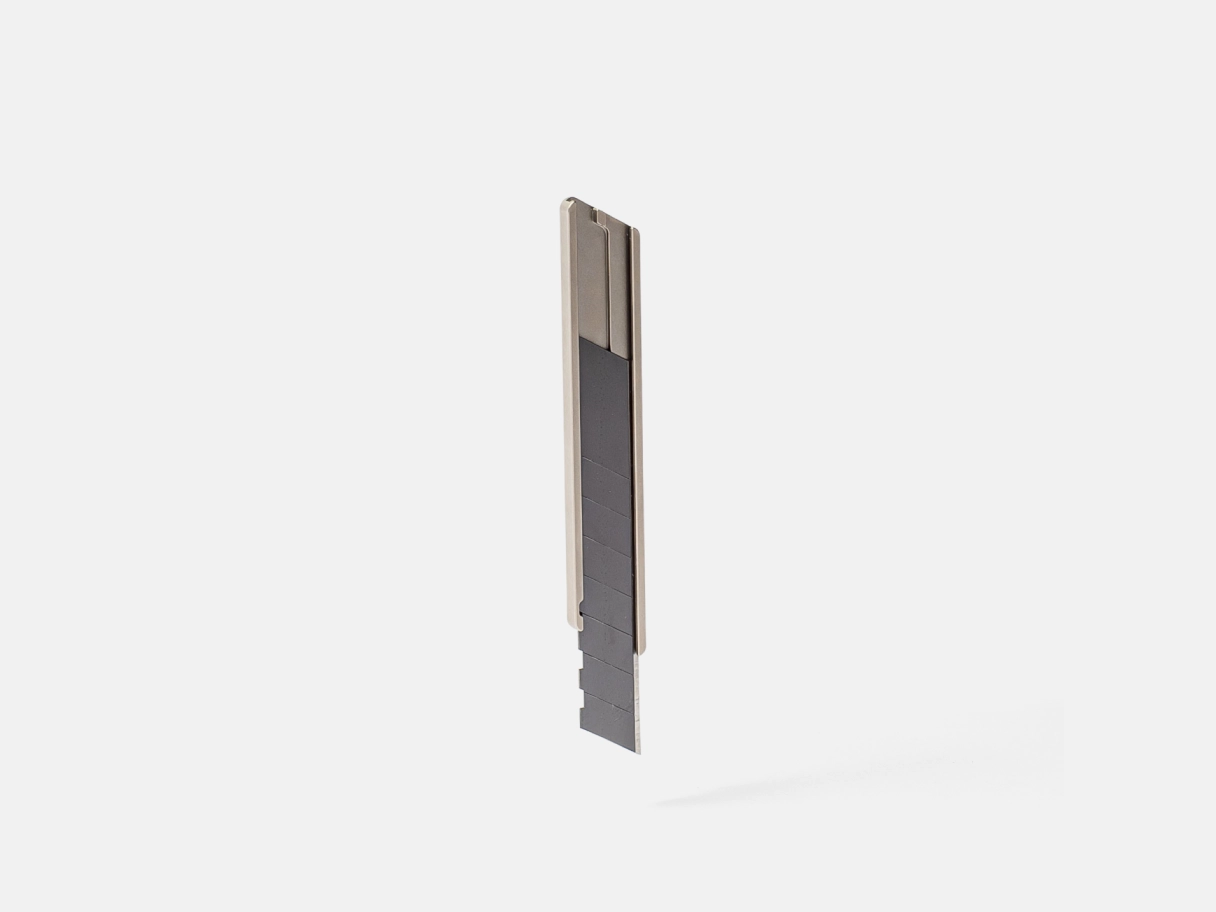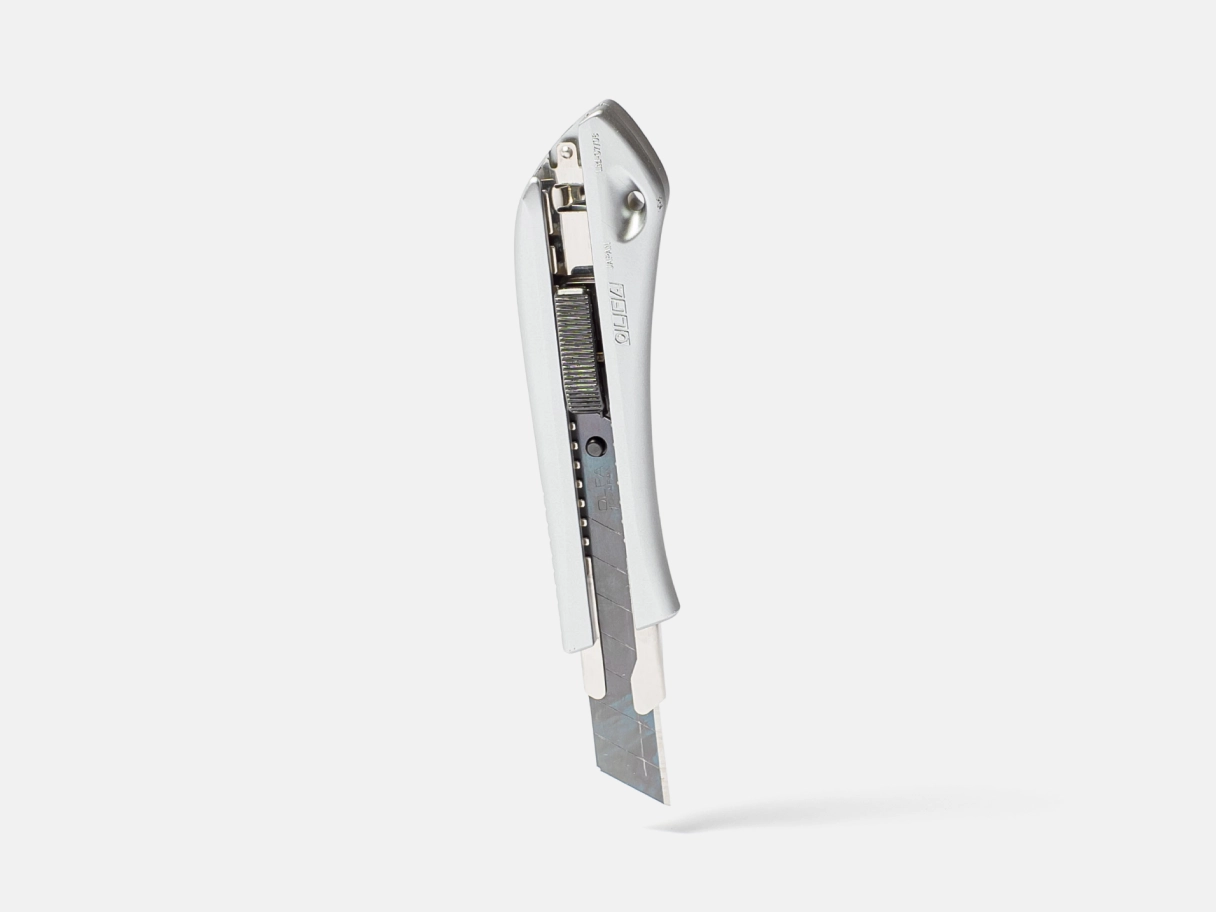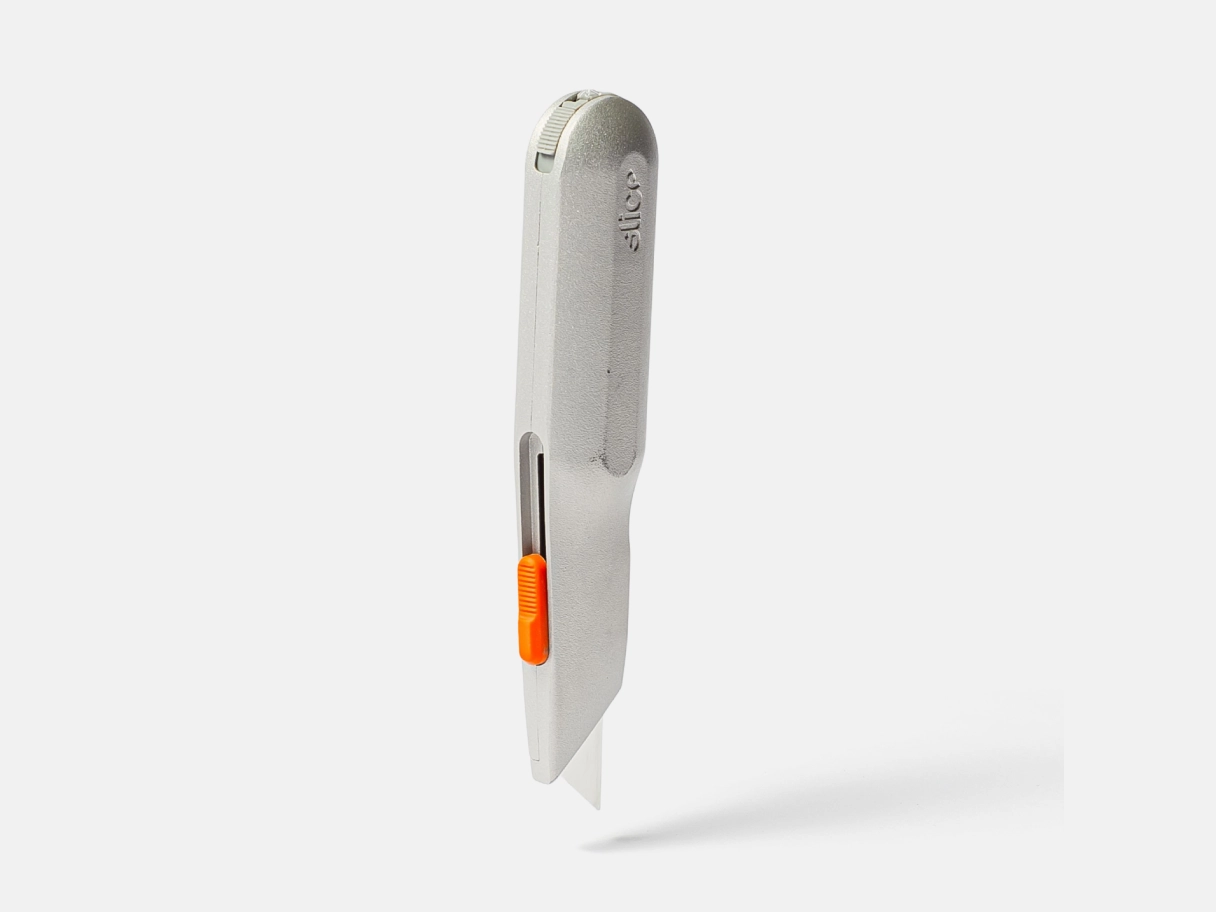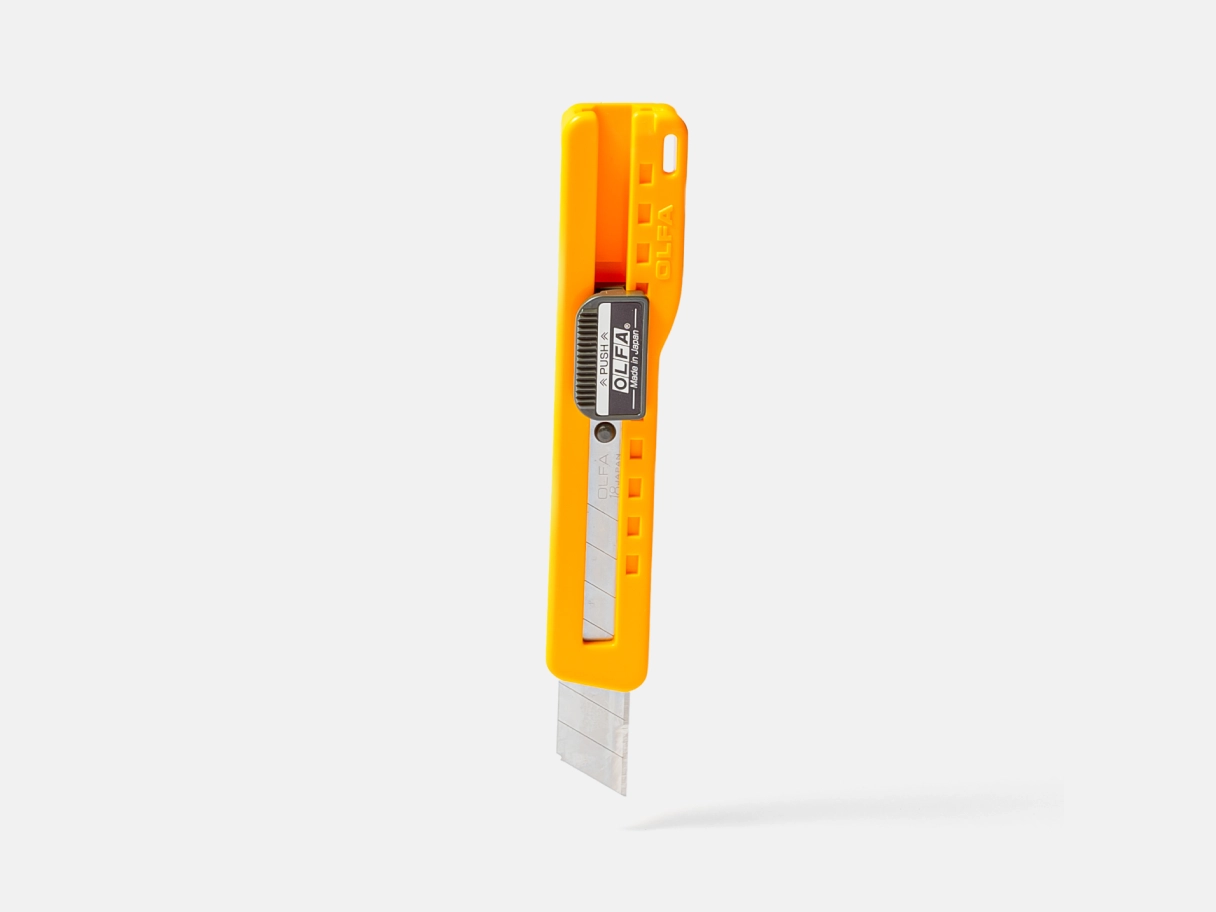

Utility knives are incredibly versatile. They can be used for everything from opening boxes to precise cutting.
Knives with fixed blades like chef knives and pocket knives require sharpening and are generally designed for a narrow set of uses. Utility knives, on the other hand, have replaceable, disposable blades. A variety of blades are available in different materials, sizes and styles like serrated or rounded tip.
This titanium knife is barely larger than the blade itself, making it well suited for fine cutting as well as larger jobs.

CW&T is the two-person design practice of Che-Wei Wang and Taylor Levy. Their work spans from interactive software to human-scaled tools that enhance our relationships to work, life and time.
The Herring Blade is one such project. Barely larger than the 18mm blade it houses within, the tiny size makes it nearly as maneuverable as a scalpel-style precision knife.
The version I tested is made of titanium with a matte bead-blasted finish. It is also available in 7075 aluminum with a Black Type-III Hardcoat and in other special limited versions.
The shape of the knife follows the shape of the blade — an elongated parallelogram. The titanium finish is soft to touch and picks up fingerprints and hand oils, giving it a natural feel. This material and finish makes the knife durable enough to last forever.
The mechanism for engaging and disengaging the blade is very elegant. This knife comes with special notched blades that are held in place by a magnet within. When you press down the blade, the blade tilts and separates from the magnet, allowing you to push it up and down. A protrusion at the front of the titanium housing holds the blade at one of the notches when you let go.
You can also use this knife with standard 18 millimeter blades that lack the notch. In this case you will need to manually hold the blade with light pressure.
The magnet within also allows you to stick the knife to a ferrous surface like a refrigerator or cabinet when not in use. Though, the magnet is a bit weak, so the knife is stable only when vertical and is easily removed by hand.
This tiny knife, available both in left handed and right handed versions, is surprisingly comfortable. This comfort is in part due to four stripes carved from the reverse of the knife that form the perfect place for my pointer finger to rest.
This isn’t to say that this is the most comfortable knife out there. It’s perfect for intermittent use. I’d pick another if you want to use a knife for hours on end.
Every detail from the small guard that prevents the blade from going past the end to the almost imperceptible bevels on the surfaces are expertly executed. This is a knife that will last generations and would make a perfect heirloom to pass down.
This knife is much more comfortable in the hand than most other blades. Yet, it's still aesthetically pleasing.

This knife is from OLFA Corporation. Founded 67 years ago in Japan, OLFA is one of the tried and true options in the world of utility knives.
The Limited AL Ltd-08 is part of a series of limited edition knives available in a variety of colors. AL refers to the auto-locking mechanism, in which the blade follows along a track that allows stopping the blade at discrete amounts. It has a counterpart, the Ltd-07, which uses a ratcheting mechanism, in which a wheel can be tightened to stop at the knife at any arbitrary point. Both use the commonly available 18mm snap-off blade.
The external housing is made from a metallic plastic, though it is available in other colors as well. The back has a rubberized grip with divots. On top, there is a thumb grip molded into the housing.
The internal mechanisms are made of steel. Given my past experience with OLFA knifes, this mechanism should last decades.
The auto lock mechanism makes it extremely easy to engage and disengage. You press in the black grip tab, allowing the knife to extend and retract along the track. Letting go locks it into one of the discrete spaces.
Releasing the blade for replacement is a little less intuitive. You must pull the grip tab down without squeezing, which allows the blade to go down instead of up.
There are part lines visible along the plastic pieces. There are also some rough edges in the rubber grip. The steel parts look very precisely put together and do not creek or wobble.
Given how affordable this knife is, the finishes and precision with which it was created are great. The comfort and ease with which the blade is extended and retracted make this a perfect one knife for all jobs.
This knife combines near indestructibility with a minimal, ambidextrous design.

Slice is known for well-designed utility knives and craft blade all using ceramic blades. The Manual Metal-Handle Utility Knife utilizes ceramic blades in the same trapezoidal shape as utility blades commonly found in home improvement stores. Therefore, you can easily replace the ceramic blade with a common metal one. It resembles affordable utility knives , but with significant aesthetic and functional improvements.
The enhanced aesthetics contribute not only to its appearance when not in use but also to its functionality. It’s constructed from a few steel pieces joined by a single exposed screw.
My unit, despite being new, arrived with a few scratches because the packaging has an open hole designed to let potential buyers touch it. However, the two pieces fit together securely, and in my usage, they have not exhibited any wobbling or creaking.
The unit’s substantial weight suggests it can withstand a fall or impact without internal damage. There is a small color-contrasted plastic button used to extend and retract the blade.
When the blade is extended, a small gray plastic button on one side allows for easy blade release. At the knife’s end, there’s a removable plastic tray for storing a replacement blade, which is particularly useful for carrying another blade, such as a serrated blade.
Despite its bulk, I find this knife to be comfortable in my hand, making it my preferred choice for extended cutting sessions. However, due to its size, I wouldn’t keep it in a compact space like my office drawer.
Given the durability of the materials and the straightforward construction using simple screws, I don’t anticipate encountering issues that require repair.
Slice claims the ceramic blades are recyclable. Similar to many manufacturers, there is a lack of information on how to recycle them. Despite my research in the Bay Area, I couldn’t locate a ceramics recycler for these blades. So, I plan to use standard metal blades after exhausting the first ceramic blade.
In addition to this simple version, there are other variations on this basic design including squeeze trigger and auto retracting versions.
I found the ergonomics perfect for breaking down dozens of cardboard boxes. The knife’s durability means I’m fine with it banging around in my toolbox.
The shape and the extension mechanism in this affordable option are simple, leading to a durable design.

Another offering from Japanese manufacturer OLFA is the SL-1. This is a straightforward rectangular plastic design housing an 18-millimeter blade. It presents a more simplistic appearance compared to other blades in the OLFA lineup.
The plastic surface is smooth, lacking grip. The internal mechanism is remarkably simple: a black clip clamps down on a track of detents. Pressing down on the clip allows the blade to freely move. Pulling it down releases the blade, allowing replacement. Pushing it out extends the blade. Let go of the clip, and two protrusions lock into the indentations.
In terms of comfort, it surpasses the herring blade, thanks to its larger size. However, I wouldn’t label it as ergonomic, given its long, straight shape. The Limited AL Ltd-08 and Slice knife are better options for long cutting sessions.
During use, engaging and disengaging this blade is slightly more challenging, requiring a firm press on the clip. The blade replacement process is extremely straightforward—simply press down the clamp and pull out the blade.
Despite being an affordable knife, all the parts are well-manufactured and assembled. The simple construction and mechanism make this knife long-lasting.
This knife can be perfect as a backup knife or in situations where you wouldn’t mind losing it.
The aesthetics of a knife should first aid in understandability and safety. For example, it should be easy to see whether or not a blade is safely closed.
Aesthetics can also influence where the knife will be stored when not in use. A beautiful knife is more likely to reside out in the open, as opposed to in a drawer or toolbox.
It should be possible to swiftly engage and disengage the blade without difficulty. The knife should firmly hold the blade. This is especially important when snapping off blade sections. The blade should be easily replaced with little chance for injury. The handle should support a secure grip.
The knife should be free of wobbles or creeks, especially when in use. Disparate parts should come together cleanly without uneven gaps. The mechanism for engaging and disengaging the blade should be simple and durable. It should never jam.
The knife should support blades that are easily recycled or disposed. It should be built well enough that it can last decades, seldom need repair and certainly never break irreparably.
I started by researching the various types of replaceable utility blades. I centered in on the common trapezoidal shaped utility blade and 18 millimeter snap off blades. There are many other types of blades available, but these blades best balance size and ease of availability.
Next, I scoured home improvement stores, small design boutiques, and awards catalogs for utility knives that use these blades. I looked at bigger companies like OLFA and Slice, and smaller design studios like CW&T.
I then narrowed the list based on the aesthetics, and then user reviews.
I tested the knives in a variety of situations like cutting boxes, wood, paper, and tricky materials like plastic tubing.
I paid close attention to how easy the knives were to engaged and disengage, how well they fit in the hand, and how my hand felt after extended use. I tested removing and replacing blades as well.
These are some utility knives that nearly made the list and why I decided not to recommend each one.